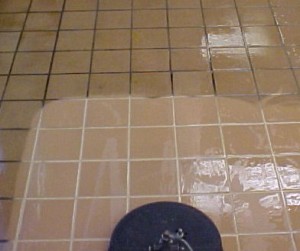Everybody is no doubt all too familiar with those tricky areas of the home that are just downright difficult to keep clean. Whether it’s a lack of time, a commonly overlooked spot or simply a place that’s awkward to get to, we all have those areas that we regularly put off cleaning.
But there are indeed easy ways to go about managing these tough spaces; ones that don’t require expensive cleaning products or the use of harsh chemicals. Not only will they save you time and money, they’ll also reduce the residue often left behind by common cleaners.
So get ready to roll up your sleeves…here’s how you can go about tackling five of the hardest to clean areas in your home.
1. The Shower Head
The shower head is a common bane of most bathrooms, as the black grimy build-up between the holes are a nightmare to clean between.
But with a plastic sandwich bag and a bit of cheap white vinegar, you can have a sparkling clean shower head literally overnight. Simply fill the clear bag with the vinegar and secure it around the shower head with an elastic band. Leave it overnight or at least for a few hours – the vinegar will simply dissolve the dirt. No more scrubbing!
2. The Stove
Over-boiled pasta water…oil spatters…burnt-on food…the top of your stove can be a hazardous place for food spillages and stains, and often requires a lot of elbow grease to scrub clean.
Simply mix one tablespoon of salt with a tablespoon of baking soda, and add one tablespoon of water. Dip your cloth into the cleanser and use it to scrub away the dirt on your stovetop with ease. When rinsed thoroughly clean, your stove will gleam like new again without scratching or smearing. Or if that sounds like too much work, hire professional oven cleaners who don’t mind living in elbow grease for a living!
3. Wooden Furniture
The repeated use of polishes or wood cleaning sprays on your wooden furniture can leave a dull residue over time and reduce the natural shine of your beautiful wooden pieces.
Leave your everyday cleaning products in the cupboard and opt for a gentler, natural approach instead. Start by washing your furniture with warm soapy water (washing up liquid is fine) and rinse and dry very, very thoroughly. Combine one cup of olive oil with a quarter cup of white vinegar in a jar with a lid.
Shake before every use to blend and apply sparingly with a soft cloth – a little goes a long way. The vinegar with bust through dirt and the olive oil will soften and moisturise the wood, giving it a pleasant shine when buffed. This wood treatment should be applied no more than once a month, but you can clean the furniture in between using a dry, soft microfiber cloth.
4. Tile Grout
Grout is that awkward filler that lies between tiles in your kitchen or bathroom. White and grey grout in particular can become dull and grimy over time, or even darkened with mould in rooms with little ventilation. Whilst bleach products do work effectively, they can be harsh and should not be used on black grout as it will cause fading.
Why not make a natural tile cleaner instead by mixing white vinegar with baking soda to create a thick paste? After drying tiles thoroughly to remove dust, the mixture can be applied generously to grout using the corner of a cloth and left for 30 minutes whilst it soaks in. You may wish to reapply frequently as it soaks into the grout, but when you are satisfied with the coverage it can be scrubbed away using a hard-bristled brush to get between the tiles.
When done, remember to rinse and dry thoroughly. This solution can be used on both floors and walls.
5. Tops of Cabinets
We all try to forget about the dirt that collects on the tops of our kitchen cupboards, but it is still very much there. Grease from cooking, dust and residue from the humidity will gather over time and sit on top of our kitchen fittings, and even some cleaning agents can leave a further residue.
This hard-to-reach area can be cleaned easily with some white vinegar and baking soda. Start by wiping the cupboards down with a soapy water solution to remove dust and lint; then use the vinegar on a cloth to scrub the light patches of sticky residue. Tougher, stickier areas can be beaten with a mix of baking soda and water in equal parts to make a thick paste. Apply it liberally before scrubbing surface clean with a soft-bristled brush.
To keep your cabinet tops clean, simply lay wax paper over the top, cut to fit the depth and width of your fittings. Every few weeks the wax paper can be ditched and replaced with a fresh piece, bringing an end to tedious cleaning.
Having a reliable, dedicated cleaning service visit your home every month will give you extra peace of mind, taking care of all these tough spots, and more. No longer will you need to worry about those unglamorous, tricky areas you dread to face, and you’ll even be given tips on how to maintain your home in between visits.
Many cleaners will be able to negotiate a schedule you are happy with, so they’ll be there when you need them most. If you find that keeping your home spotless and gleaming is an endless cycle, then give a local cleaning company a call.
Adele Halsall is a budding cleaning wizard working at Skweeky Kleen, a commercial and domestic cleaning company based in Bristol, England.


